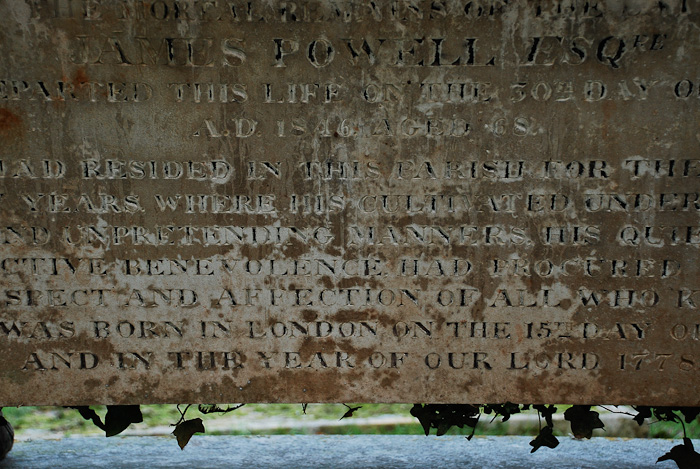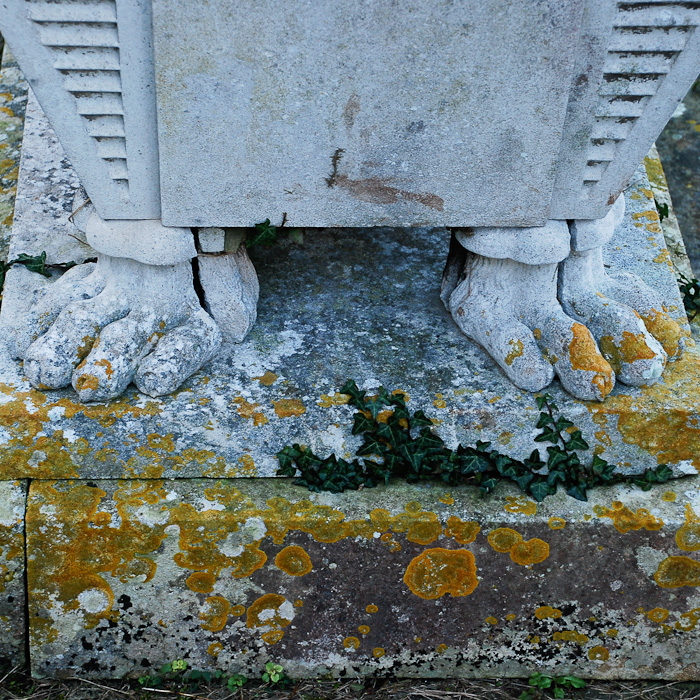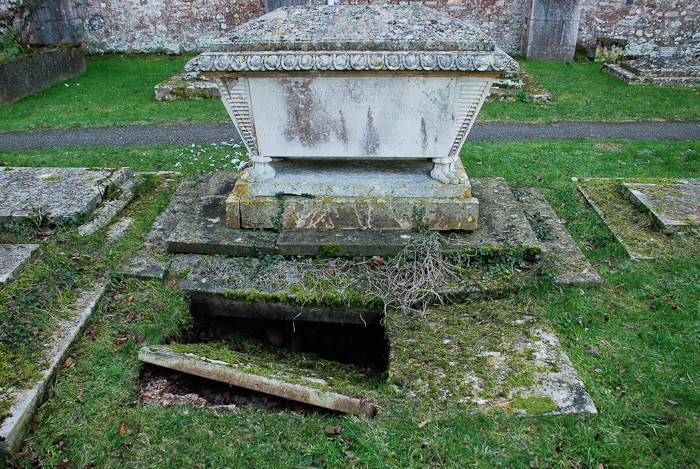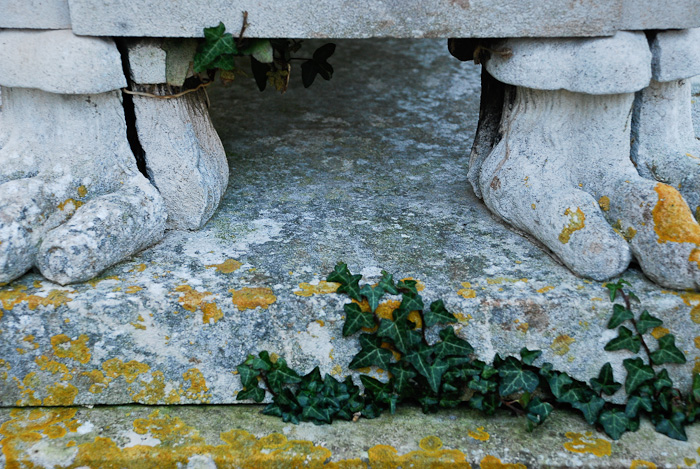Monument to James Powell (1778 – 1846), St Gregory’s churchyard, Dawlish.
* * * * *
On New Year’s Day I went looking for the grave of Richard Harris Dalton Barham (1815 – 1886). R. H. D. Barham was the son and biographer of Richard Harris Barham (1788 – 1845), author of The Ingoldsby Legends. He retired to Dawlish from Lolworth, Cambridgeshire, in 1863 and according to the History and Guide to St Gregory’s Church was buried in the churchyard in 1886. Finding one grave among so many was a long shot and so far I haven’t managed to track him down, but my other discoveries were interesting enough to make the expedition worthwhile.
Until I read Richard Holmes’s book Sidetracks: Explorations of a Romantic Biographer I knew almost nothing about The Ingoldsby Legends. I’m not a great fan of ghost stories, especially comic ones, but the biographical facts about the Reverend Barham senior, aka Thomas Ingoldsby, were peculiar enough to hold my attention. Some of his Romney Marsh ‘double-goer’ stories, published from 1837 onwards, were forerunners of R L Stevenson’s Doctor Jekyll and Mr Hyde (1886), and the food imagery in his poem Nell Cook!, a tale of the ‘Dark Entry’, seems to anticipate Christina Rossetti’s Goblin Market (1859).
There are only a few burials on the north side of the churchyard and I delayed investigating there until I’d looked for Mr Barham’s headstone in the sunnier areas. When I finally ventured along the gloomy path the first thing I saw was the half-eaten remains of a pigeon lying on the ground. As my eye roamed across the scattered feathers, it encountered a foot…
Since I was last in this part of the graveyard an adjoining slab had broken – the sight of a skull lying in the uncovered hole was almost too exciting. Luckily it turned out to be just a large, smooth stone. On a summer day the atmosphere of benign neglect makes St Gregory’s churchyard feel like a Stanley Spencer painting, but on such a cold morning the stories of Thomas Ingoldsby began to seem somewhat less fantastic…
NELL COOK!
From The Ingoldsby Legends
‘But I’ve been told that moan and groan, and fearful wail and shriek
Came from beneath that paving-stone for nearly half a week –
For three long days and three long nights came forth those sounds of fear;
Then all was o’er — they never more fell on the listening ear.
* * * * *
James Powell Esquire and his wife Elizabeth
The overall elegance of the monument seemed strangely at odds with those feet, and after I got home I set to work to decipher the inscription. It reads as follows:
BENEATH THIS STONE ARE DEPOSITED
THE MORTAL REMAINS OF THE LATE
JAMES POWELL ESQUIRE
WHO DEPARTED THIS LIFE ON THE 30th DAY OF AUGUST
AD 1846 AGED 68
HE HAD RESIDED IN THIS PARISH FOR THE LAST
TWENTY YEARS WHERE HIS CULTIVATED UNDERSTANDING
HIS MILD AND UNPRETENDING MANNERS, HIS QUIET VIRTUES
AND ACTIVE BENEVOLENCE HAD PROCURED FOR HIM
THE RESPECT AND AFFECTION OF ALL WHO KNEW HIM
HE WAS BORN IN LONDON ON THE 15th DAY OF MAY
AND IN THE YEAR OF OUR LORD 1778
A further inscription to his wife on softer stone along the north side of the monument has partly worn away: her name was Elizabeth and she died on April 27th 1856 at the age of 72, ‘deeply loved and respected by all who knew her’. Since James was obviously a pillar of the community and Elizabeth presumably commissioned the memorial the mystery seemed to deepen. Could she have been sending some kind of message?
* * * * *
Isambard Kingdom Brunel, James Walker and The Earl of Devon.
From a leaflet produced by Dawlish Community Trust, 2007
‘The original (1843) plans by Brunel for the coastal route were modified after a detailed inspection by the Admiralty Engineer, James Walker, who recommended that the sea wall run continuously from Powderham to Teignmouth with a public footpath to compensate for the loss of facilities used by boatmen, fishermen and the public at large.The Earl of Devon disliked the idea along the Exe and prevented it. The path started at Dawlish Warren and ran at the level of the track until Sea Lawn (between the footbridges at Rockstone Flats and Coastguards) and from Coastguards to Kennaway tunnel in Dawlish. Sea Lawn was a casualty of Brunel’s route. It was built by James Powell as his home and had extensive gardens at the foot of the cliff. The line was routed only a few yards in front of the house but Powell managed to get compensation and the level of the seawall footpath reduced along his frontage to avoid overlooking by the general public. Although Powell died in 1846 and the Railway purchased Sea Lawn the continuity of the seawall footpath was not remedied. His house was demolished in 1888 for the construction of Sea Lawn Terrace.’
It would be nice to think that Mrs Powell spent some of the compensation money on a ghastly monument which would stalk the footpath beside the SDR when the moon was full, but perhaps that’s a bit optimistic.
There are at least two more sidetracks which could be followed – it seems that James Powell was related to the Baden-Powells of Boy Scout fame, and also possibly to the James Powell who founded Powell’s of Whitefriars. This company, also known as Whitefriars Glass, produced much of the glass and tilework to be found in many Victorian Church interiors, including as it happens, the decorations around St Gregory’s altar. However, I’ll give the last word, such as it is, to the as yet unlocated R H D Barham:
‘Reaching down where the fresh and the salt water meet,
The roofs may be seen of an old-fashioned street;
Half village — half town, it is — pleasant but smallish,
And known, where it happens to be known, as Dawlish…’
From The Monk of Haldon: A Legend of South Devon (1880)by R H D Barham
* * * * *
Text and photos © Angela Williams, 2009
LINKS




